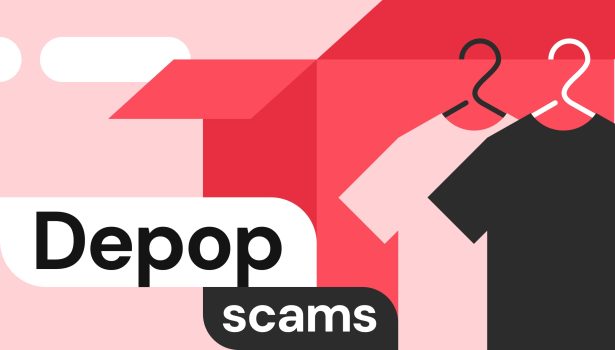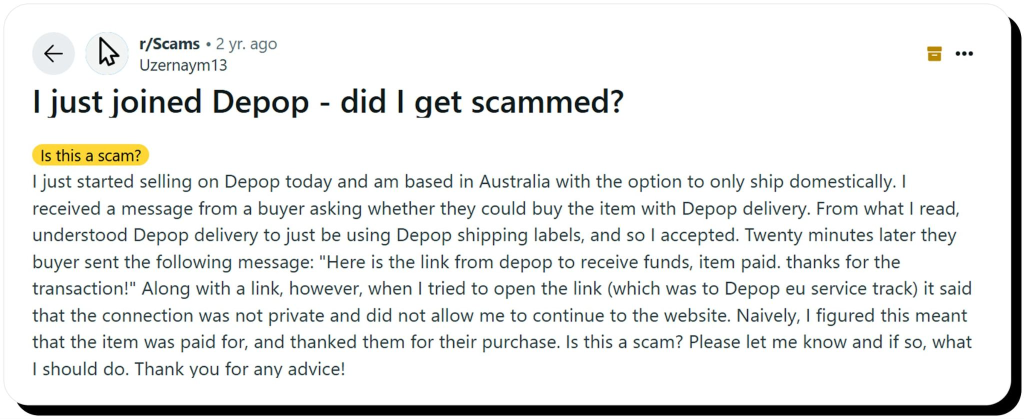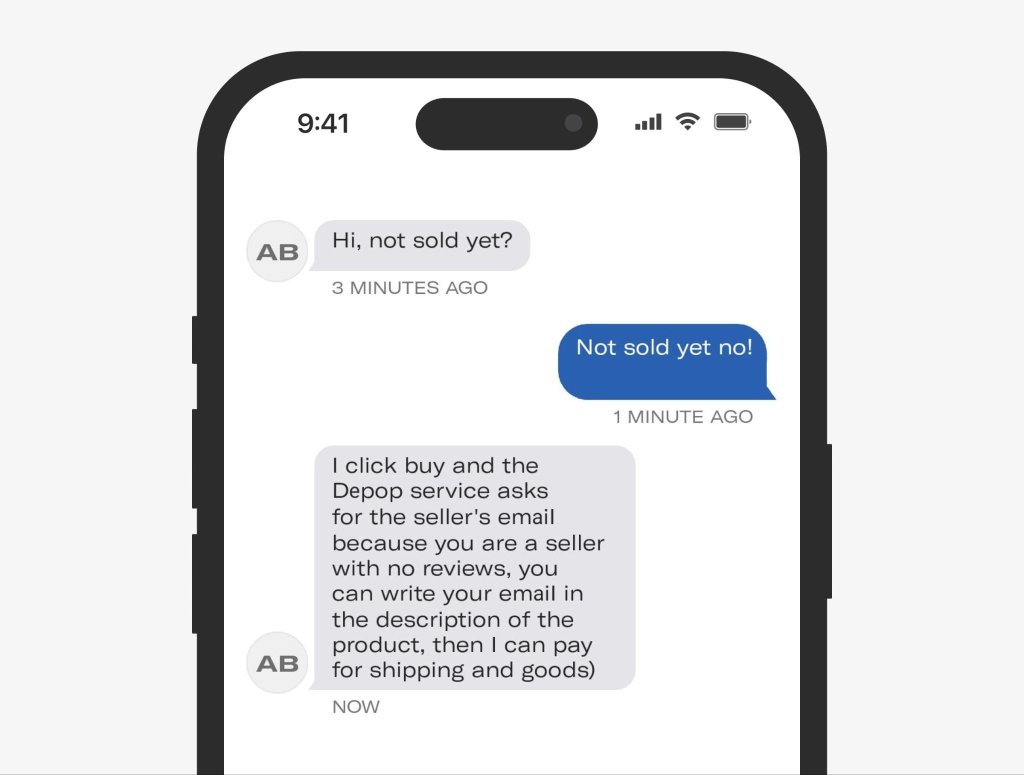Depop scams: how to spot and avoid them

Depop is a social e-commerce platform for buying and selling second-hand (pre-loved) fashion items. With over 43 million registered users, Depop has become a go-to hub for finding affordable clothing, footwear, and accessories, from vintage items to modern streetwear.
Along with legitimate users, however, Depop also attracts scammer crowds who prey on both sellers and buyers, especially those new to the platform.
In the article below, you’ll find everything you need to know about Depop scams, how to know if Depop sellers and buyers are legit, and how to make your shopping experience there as safe and enjoyable as possible.
Common Depop scams
There are various Depop scams, but many of them resemble those you’re likely to encounter on other online resale marketplaces, such as Poshmark scams or OfferUp scams. Once you learn to recognize and steer clear of fake sellers and buyers, you can engage in social commerce safely practically everywhere.
Let’s review the top scams you might run into on Depop.
Off-platform transactions
Even though Depop explicitly states that users should stay on the platform to sell, buy, and ship, there are various tricks malicious actors use to take you elsewhere to avoid Depop’s protection.

In most cases, fake sellers will try to move your conversation to a private messenger and persuade you to pay via a wire transfer, an instant money transfer app, as seen in Venmo scams, or PayPal, specifically using the “friends & family” option, which is a common Depop PayPal scam. If you follow these instructions, you will lose Depop’s buyer protection and are likely to never receive the item you paid for.
Fake listings
Can you get scammed on Depop as a buyer? Unfortunately, yes, and fake listings are just one of the buyer scams on Depop.
Fake listings on Depop are rare, as the platform has strict rules against using fake or stock photos in listings. However, scammers find workarounds, such as posting stolen non-professional photos of items they don’t actually own while greatly lowering the price to make them more attractive, especially for high-demand items.
These scammers might also insist on transacting outside Depop, which is another red flag. Their goal is to make you pay, preferably off-platform, so they can take your money and disappear without sending you the purchased item.
Phishing scams
Scammers prey on new Depop sellers who’re not yet familiar with the platform’s policies. That’s why, when they get a link from a “buyer” to “receive funds” or provide “missing information” to complete an order, many fall for it.
These links turn out to be phishing traps designed to harvest sensitive information. This can range from contact details to Depop credentials and credit card data.

A variation of Depop email scams includes asking for the seller’s email address or other personal information to continue sending phishing messages later.

Fake payment confirmations
Can you get scammed on Depop as a seller? Yes, especially if you’re new to the platform.
For example, by exploiting sellers’ lack of knowledge and experience, Depop scammers may succeed in obtaining their email addresses and then send fake payment or order confirmations that mimic Depop’s legit emails. In reality, this is just a trick to make the seller believe the transaction is complete so they will ship the item. If the seller follows through, the scammer gets the item for free, and the seller has no way to receive the due payment.
Refund scams
Fake buyers on Depop may submit fraudulent refund claims, marking their purchased item as “not as described” after tampering with it, replacing it with a poor replica (such as a counterfeit item), or damaging it intentionally. They may also return a completely different or damaged item while keeping the original.
Unfortunately, this scam is scaling up now as scammers use generative AI tools to fake damage in item photos and present them as proof to secure successful refunds. While ways to combat this fraud are still limired, it’s advised that sellers document their items in detail, along with the shipping label, before dispatching. If an item is damaged in transit and the sale qualifies for Depop protection, the seller may be refunded.
Bait-and-switch scams
In some cases, buyers become targets of bait-and-switch or swap scams, where fraudulent sellers replace the actual item with another one that’s typically much cheaper. Unless the purchase happens on Depop from start to finish, and the buyer has documented evidence of receiving the wrong item, they will have a hard time getting a refund.
Scammers exploit this loophole and often pressure buyers to move your transaction off Depop and use third-party shipping services to avoid responsibility.
Overpayment scams
Fake buyers on Depop may “accidentally” transfer more money than the requested price and beg you to refund them the difference.
This is a common trick used to defraud marketplace sellers. For example, it’s one of the common Mercari scams going around. In fact, the funds used for such “accidental” transactions are often taken from stolen credit cards or hijacked payment accounts, which means the transaction can later be disputed as unauthorized. In other instances, scammers may initiate a chargeback on the transaction, keeping both the initial sum and the amount “refunded” to them by the victim.
Non-delivery fraud
Fraudulent buyers may pretend they never received the package, even if tracking information shows the item was delivered. Without proof of signature and end-to-end tracking, it can be hard for the seller to prove they’ve fulfilled their part and shipped everything correctly, especially if they used third-party services. As a result, the seller is likely to lose money in a dispute with the buyer, who will be able to both keep the item and get a refund.

How to identify a scam on Depop
Unfortunately, despite all the precautions, people are getting scammed on Depop all the time, reportedly losing almost $3,000 on average.
Awareness is key to battling Depop fraud, so go through the following red flags and signs of legitimate buyers and sellers to transact on Depop safely:
How to know if a Depop seller is fake
To determine if a Depop seller is legit and filter out fake ones, avoid sellers showing the following red flags:
- New accounts with zero history of sales and no positive (or realistic) reviews from past buyers.
- Vague or copy-paste descriptions that don’t match the item in the photos.
- Suspiciously low prices, especially for high-demand and luxury items.
- Pressure to take the conversation off the platform.
- Insisting on payments via wire transfers, PayPal for Friends & Family, Venmo, Zelle, Cash App, crypto, or gift cards. None of these methods offers adequate buyer protection in case of a scam.
- Requests for personal contact details, such as an email address or a phone number.
How to identify a fake Depop buyer
Likewise, fake Depop buyers often show the same characteristic behaviors that can help you identify when you’re likely being targeted by a scammer:
- Asking to take the conversation off Depop.
- Requests for unusual shipping methods or asking you to send the item before the payment is processed.
- Asking to change their delivery address after you’ve shipped the item.
- Pushing for alternative payments instead of those authorized by Depop.
- Sharing links to pages allegedly leading to Depop login, “payment card confirmation,” or “account approval” pages.
- Accidentally “overpaying” and asking for a refund of the difference.
- Asking for personal contact details.
- Claiming they’ve paid shipping fees and sending confirmation screenshots or links leading to shady third-party shipping companies you’re not familiar with.
What to do if you get scammed on Depop
Here’s what you can do if you fell victim to a Depop scam, depending on whether you’re a seller or a buyer:
If you’ve been scammed on Depop as a seller:
If you communicated and transacted with the scammer outside the platform, there’s not much recourse you can have as a Depop seller. Even if you stayed on Depop but clicked a malicious link sent by the fake buyer that stole your credit card data, Depop is unlikely to help you in this matter either.
Still, following these steps can help you reduce the damage:
- Document everything by saving screenshots of messages, listings, and payment confirmations, and avoid deleting your chat history, as it may help in the investigation.
- Report the scammer to Depop through the platform using these instructions.
- If you received an email or message impersonating Depop, contact their support team directly and describe the issue.
- If you transferred any money to the scammer, such as in a refund scam, contact your bank or payment provider to try and reverse the transaction. If you believe the scammer may hold your payment card data, block and reissue the card to avoid misuse.
- If you shared any sensitive information with the scammer and suspect it’s been stolen, change passwords for all affected accounts. Consider filing a report with IdentityTheft.org (in the U.S.) if these details included your Social Security number, full name, home address, or driver’s license.
If you’ve been scammed on Depop as a buyer:
If you’ve been scammed on Depop as a buyer, you can only request a refund if you followed the rules for qualifying for Depop protection—that is, you stayed on the platform and used Depop-supported payment methods.
In this case, you will be eligible for Depop protection, provided you’re based in the U.S., UK, or Australia. If the item is lost or damaged in transit, or if the item you received is significantly not as described, you can start a dispute in Depop’s Dispute Resolution Center.
In cases where you transacted with the scammer outside Depop and/or used third-party payment methods not authorized by the platform, or if you’re located outside of the regions covered by Depop protection, you won’t be able to get a refund. However, there are other recommended steps you can take to minimize the damage:
- Document everything and report the seller to Depop using the instructions mentioned above.
- Contact your payment provider to dispute the transaction and initiate a chargeback, if possible.
- If you think your payment data is known to the scammer, block and reissue your card.
- If you entered your personal information, shared your email, verification codes, or account credentials on malicious websites, change all affected credentials.
- Report the scam to the Federal Trade Commission and Better Business Bureau, if you’re based in the U.S.
Does Depop offer buyer or seller protection?
Yes, Depop offers both buyer and seller protection, but only under limited circumstances. Their policy lists a range of conditions that must be satisfied for a user to qualify:
- For buyers: You’re protected if you’re based in the U.S., UK, or Australia and purchased the item through Depop’s Buy button. If the item does not arrive, is damaged in transit, or is significantly not as described, you may be eligible for a refund after your dispute is successfully resolved.
- For sellers: You’re protected if items are lost or damaged in transit, provided you sold the item using Depop’s Buy button, shipped to the buyer’s exact address using a Depop shipping label within 5 days of the transaction date, and the transaction value doesn’t exceed $300 (£250/$300AUD).
So yes, Depop does refund scams, but only if the above conditions are met. In other cases, especially if the transaction and shipping occurred outside the platform, Depop’s protection is not available.
How to avoid Depop scams going forward
As a rule, Depop scammers are able to get away with their exploits because users break the golden rules of peer-to-peer marketplaces: never take the transaction off the platform and always use the payment and shipping methods listed as official. The moment you leave the platform to sell or buy, you’re no longer covered by the platform’s user protection policy.
Other essential safe practices include the following:
- Check user reviews and account history.
- Never share your contact details with other Depop users.
- Never enter your personal information on suspicious websites. Always verify that the URL is legitimate.
- Block any attempts to move communication to a private messenger or another website.
- Be cautious if the listing seems too good to be true.
- Ask for additional item photos or proof of authenticity for luxury items.
- Use only tracked and signed delivery methods.
- Document the items before you ship them (for sellers) and upon arrival (for buyers) to use in the dispute process if needed.
FAQs
Is Depop a scam?
No, Depop is a legitimate social commerce platform for reselling fashion items. Like on any other marketplace, there are still many scammers looking to steal money or sensitive information from legitimate users.
What happens if you get scammed on Depop?
Depop scammers are likely to steal your money, items, or, in worst-case scenarios, identity. To prevent this, follow safe shopping practices and always keep your transactions on Depop.
Can I get my money back if I was scammed on Depop?
In certain cases, Depop offers refunds under their buyer protection program. To qualify, you should buy using Depop’s Buy button, avoid moving your transaction to another platform, and be based in the U.S., UK, or Australia. Depop reserves the right to handle disputes at their sole discretion.
Are Depop scams common?
Yes, Depop scams are common, but most of them occur only if users take transactions off the platform. To protect yourself, follow Depop’s safety guidelines and only interact with users who have a proven history of sales and purchases on the platform.





Dimitri is a tech entrepreneur and founder of Onerep, the first fully automated data removal service. Top cybersecurity CEO of 2021 by The Software Report.